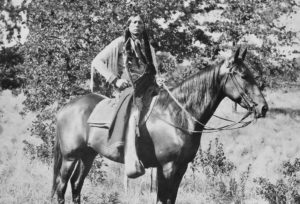
The film’s location, the nearly 60,000-acre Wichita Mountains Wildlife Refuge near Cache, is as photogenic as ever. Ron has a magnificent view of the mountains from his ranch, a land allotment that he said has been passed down through generations of his ancestors.
“Their spirits are here with us,” Ron said while sitting within a sacred outdoor ceremonial space that he and daughter Cindy had created. “Natives are tied to nature,” he said. “That’s the way we are. There is nothing here. Except to me, it’s beautiful. I sit out here and watch the horses. They come in every evening from town. I just love it. It’s my life, really.”
As Ron spoke, sounds of Native American flute floated in the wind, paint horses roamed freely, and the smell of smoke from an open fire blended with that of burning sage as Cindy performed a ritual with sacred eagle feathers.
“I smudge and cedar every day” Cindy said. “It’s a blessing. The medicinal remedy creates peace. It brings you kind of back down to that simple level. That’s what our ancestors did. They just had these medicines, and the pipe, and the flute, and the song.”
Between bites of fry bread, Ron and Cindy talked about the Comanche way of life.
“This is Comanche County,” Ron said. “This is restricted land. We pay no taxes on it.”
The Comanche headquarters are in Lawton, and Ron said the tribe, which has more than 15,000 members, is doing well today.
One of 11 children, Ron was born about half a mile from his ranch in the cold of January.
“Grandmother,” Cindy said, “tells the story of him being born inside a tent. There was too much snow to get the team together and get to town.”
Ron explained how when land allotments were distributed through the Dawes Act, native-owned land was checkerboarded, which further separated the Comanche from their traditional ways.
“The white way, assimilation, really jumbled us up,” Cindy said.
Before moving back to Cache in February, Cindy was a substance abuse counselor in California, where she had lived for more than 20 years.
“Treatment with ceremony has helped our people tremendously,” she said. “When we bring people into treatment, Native American people, it all goes back to ceremony. It doesn’t matter what tribe they are in. They come to a place where they give up. It’s like being reborn.”
An American Indian blanket lying across the table where Cindy and Ron ate and talked served as a tablecloth. Nearby stood the framework of a sweat lodge.
“When we hold a sweat event, [people] go in there and sing and pray or whatever they want to do,” Ron said. “It’s like a sauna. It gets real hot. You can hardly breathe in there.”
Cindy said a family sweat ceremony to promote wellness will be held on the property during the week of Christmas. She said native ceremonies create a special, peaceful feeling that many people do not experience until they are on their death bed.
“I know that [peace] every day,” she said. “I’m Comanche. I’m Sioux, too, but mostly I’m human. This house … I was kind of raised [here]. My mother … she died here. Around here, everybody’s family.”
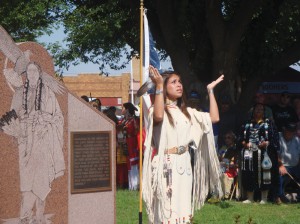
Ron said the ceremonies provide spiritual cleansing.
“My world is spiritual,” he said. “That’s the world I come from. That’s the world I like.”
However, Ron added that he can also walk in the modern world, and he talked about how Quanah had been a leader in two worlds. After Quanah led his people to Fort Sill in Oklahoma in 1875, he became a statesman, a rancher, and a businessman, who owned interest in a railroad and also negotiated leases with cattlemen.
“He had this warrior-leader life,” Ron said. “They say he was rich. I don’t know where it went. We never saw any of it. He gave a lot of it away. He was a bighearted man.”
Quanah had more than half a dozen wives, and before his death in 1911, he had lived in a two-story home known as the Star House at Fort Sill.
“You couldn’t get by with that today,” Ron said. “They mentioned to him that you couldn’t have that many wives. [Quanah] said, ‘You tell them who’s going to go.’ ”
It was not uncommon for Comanche men to take more than one wife, Ron said. However, Quanah’s father never took another wife after Cynthia Ann.
Quanah himself was a spiritual man and a member of the Native American Church, whose ceremonies incorporate the use of peyote. A cactus with medicinal purposes as a hallucinogen, peyote is drunk or eaten as an enhancer during religious ceremonies.
Ron said White Parker, one of Quanah’s sons and one of the film’s stars, became a preacher and tried to convert his father to Christianity. But Quanah balked.
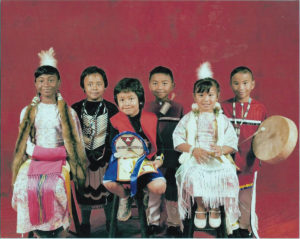
Quanah “prayed to the Great Spirit,” Ron said. “He believed in something higher than he. But he never did go to Christianity. He continued to believe in his Native American religion, which was the good way.”
Ron’s brother Don is a member of the Native American Church.
“They squat all night and sit and sing and pray and take their peyote,” Ron said.
Ron also said the Comanches are well known today for the same things they were notorious for in the past.
“The Comanche were a very proud people,” he said. “I don’t think we’re any different than any other tribe. We still love horses. The Comanche were good warriors of the plains. A lot of people agree about the Comanche. They’re fighters.”
Quanah was an expert horseman, led warriors in the second Battle of Adobe Walls in 1874, and held Palo Duro Canyon as a stronghold during the Red River War, but was not the only warrior in the family.
Quanah’s grandfather, “Iron Jacket,” known for wearing a coat of chain mail, was so legendary that bullets were said to fly away from him in battle.
Ron is no stranger to battle himself. After graduating from Indiahoma Public Schools in 1962 and going to Northwestern Oklahoma State University, he joined the military, did a tour in Vietnam, and began his career working for insurance companies. During his time with the Indian Health Services, he worked in Oklahoma, Arizona, Tennessee, New Mexico, and Maryland. After retiring eight years ago, he moved back to Cache.
When he isn’t spending time with his grandchildren, he maintains the Quanah Parker family tree and website, plans and coordinates events, gives presentations, and answers questions that people have about Comanche history.
“Really, what I do is culture,” he said. “The world and life Quanah led us into has been good to me. I make effort to preserve and promote the life of our ancestors.”
Ron said he sees The Daughter of the Dawn as an important part in preserving the culture of the Comanche, the Lords of the Plains.
Ron later talked about his great grandfather’s statue in the Stockyards.
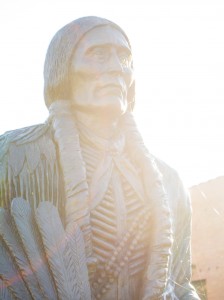
“Quanah is well known around Fort Worth,” Ron said. “He almost got killed there. They blew the furnace out. They didn’t know it was gas. It killed his father-in-law.”
Ron was referring to the incident in which Quanah and Chief Yellow Bear were sharing a room in the late 1800s at the historic Pickwick Hotel. One of the chiefs blew out the gas light before going to bed but didn’t turn off the gas.
Ron said Quanah never saw his mother again after her recapture, but before his death he wrote to Texas Gov. Thomas Mitchell Campbell to retrieve her remains. They now rest with Quanah’s and his sister’s at Fort Sill Cemetery.
“Quanah never forgot her,” Ron said. “And because he loved his mother, he decided to take her name. His spirit lives on.”
Cindy said Ron named one of her sons Quanah. The boy is now 6.
“We think when we name somebody there’s a purpose for that,” she said. “He’s a very spirited little boy. [Quanah’s] name will always be tied to that little boy. In that, [Quanah’s] legacy will continue.”






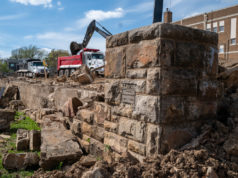





Excellent article placing the film in an historical context. I learned a lot from the information and ties to Fort Worth. The film is unique and we had a really successful presentation earlier this year as a co-sponsorship of Austin Film Society, Texas Archive of the Moving Image, and Humanities Texas. It’s great that people in the DFW area will be able to see DAUGHTER OF DAWN early next year at UT-Arlington (my undergraduate alma mater).
White man come. Take land. Kill buffalo.
And so it goes, nothing new to see then…same’ol, same’ol today. You know very many hammer-headed, Repug Tea-Baggers? When Lyndon Johnson, as America’s President, caused our country to begin acting like we believed Black people were entitled to common decency, fairness, & respect, well…the snot-rag, bastard, bigots bailed out on the Democratic Party almost in their entirety…. thank you Jesus. Texas and the South mostly votes hammer-headed, black-hearted, hooray for me,,,screw you Repug Party from then until today. Texas had been a consistent Democratic state up until that time, but no more. You will not read about this in the school books, however it’s the truth, on the record. Texas also writes the school books for our nation…true, see? Check these facts out first, then tell the butt-wipe Repugs to kiss your hiney. May God bless America and all our ships at sea.
Hello, I am a desecndent of Esther LeBarre. She is my great, great aunt.You ran her picture in the paper last week in a write up about Daughter of the Dawn. She was the female star of the film. Although I understand that Quanah Parker and his children are a bit more famous, I was quite surprised that her name was not mentioned once in the article. My family still holds to our traditions as well. I am the youngest in a line of Kiowa Comanche bead workers. I’d appreciate if you drop a note back to me. Thanks! -Autumn Marie Moss